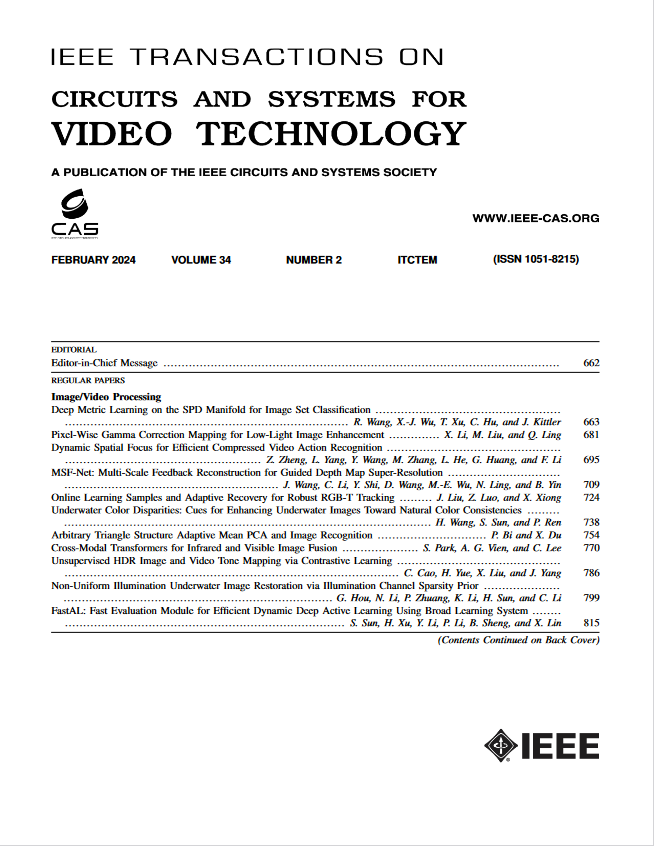在线处理视频质量评估:从空间采样到时间采样
IF 8.3
1区 工程技术
Q1 ENGINEERING, ELECTRICAL & ELECTRONIC
IEEE Transactions on Circuits and Systems for Video Technology
Pub Date : 2024-08-26
DOI:10.1109/TCSVT.2024.3450085
引用次数: 0
摘要
随着多媒体处理和深度学习技术的迅速发展,特别是在视频理解领域,视频质量评估(VQA)取得了重大进展。虽然研究人员从设计高效的视频质量映射模型转向了不同的研究方向,但对VQA模型中时空建模的有效性-效率权衡的深入探索仍然不够。考虑到视频具有高度冗余的信息,本文从时空联合采样的角度对这一问题进行了研究,旨在寻求在将视频输入VQA模型时,在可接受的性能牺牲下,我们至少应该保留多少信息的答案。为此,我们从空间和时间两个维度对视频的信息进行彻底采样,然后将严重压缩的视频送入稳定的VQA模型。在6个公共视频质量数据库上进行了时空联合采样的综合实验,结果表明,在丢弃大部分视频信息时,VQA模型的性能是可以接受的。在此基础上,利用提出的时空联合采样策略,初步设计了一个由空间特征提取器、时间特征融合模块和全局质量回归模块组成的在线VQA模型。通过定量和定性实验,验证了在线VQA模型简化和减少输入的可行性。本文章由计算机程序翻译,如有差异,请以英文原文为准。
Video Quality Assessment for Online Processing: From Spatial to Temporal Sampling
With the rapid development of multimedia processing and deep learning technologies, especially in the field of video understanding, video quality assessment (VQA) has achieved significant progress. Although researchers have moved from designing efficient video quality mapping models to various research directions, in-depth exploration of the effectiveness-efficiency trade-offs of spatio-temporal modeling in VQA models is still less sufficient. Considering the fact that videos have highly redundant information, this paper investigates this problem from the perspective of joint spatial and temporal sampling, aiming to seek the answer to how little information we should keep at least when feeding videos into the VQA models while with acceptable performance sacrifice. To this end, we drastically sample the video’s information from both spatial and temporal dimensions, and the heavily squeezed video is then fed into a stable VQA model. Comprehensive experiments regarding joint spatial and temporal sampling are conducted on six public video quality databases, and the results demonstrate the acceptable performance of the VQA model when throwing away most of the video information. Furthermore, with the proposed joint spatial and temporal sampling strategy, we make an initial attempt to design an online VQA model, which is instantiated by as simple as possible a spatial feature extractor, a temporal feature fusion module, and a global quality regression module. Through quantitative and qualitative experiments, we verify the feasibility of online VQA model by simplifying itself and reducing input.
求助全文
通过发布文献求助,成功后即可免费获取论文全文。
去求助
来源期刊
CiteScore
13.80
自引率
27.40%
发文量
660
审稿时长
5 months
期刊介绍:
The IEEE Transactions on Circuits and Systems for Video Technology (TCSVT) is dedicated to covering all aspects of video technologies from a circuits and systems perspective. We encourage submissions of general, theoretical, and application-oriented papers related to image and video acquisition, representation, presentation, and display. Additionally, we welcome contributions in areas such as processing, filtering, and transforms; analysis and synthesis; learning and understanding; compression, transmission, communication, and networking; as well as storage, retrieval, indexing, and search. Furthermore, papers focusing on hardware and software design and implementation are highly valued. Join us in advancing the field of video technology through innovative research and insights.

 求助内容:
求助内容: 应助结果提醒方式:
应助结果提醒方式:


